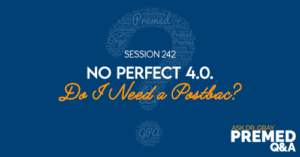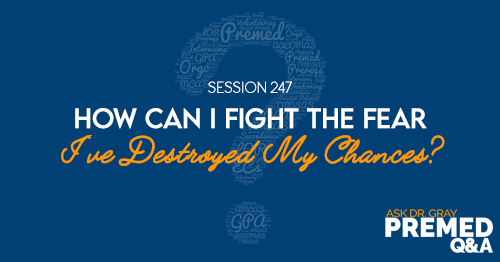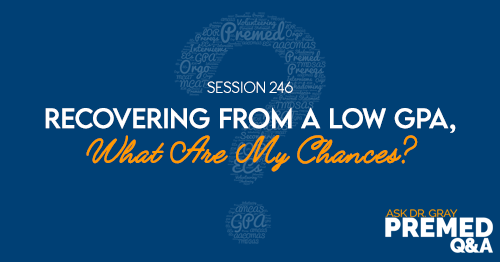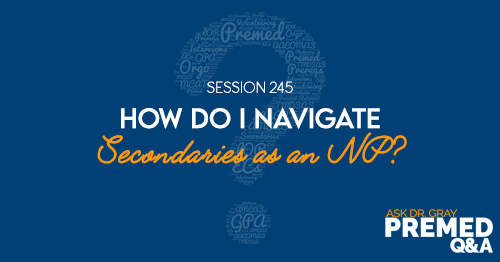Apple Podcasts | Google Podcasts
Session 242
Diving headfirst into the turbulent waters of GPA concerns and post-graduate decisions, this biology major student stands at the crossroads of their academic journey, seeking guidance.
Ask Dr. Gray: Premed Q&A is brought to you by Blueprint MCAT. Listen to this podcast episode with the player above, or keep reading for the highlights and takeaway points.
The episodes in this podcast are recordings of our Facebook Live that we do at 3 pm Eastern on most weekdays. Check out our Facebook page and like the page to be notified. Also, listen to our other podcasts on MedEd Media. If you have any questions, call me at 617-410-6747.
Question of the Day:
- “I am about to enter my senior year as a biology major and I have some concerns about my GPA. Currently, my cumulative GPA is 3.6 and my Science GPA is 3.3. I plan to take an additional eight credits of science classes next year with the aim of raising my GPA before graduating in spring. However, if I don’t manage to achieve a perfect 4.0 in these science classes, would you still recommend a post-baccalaureate or SMP? For instance, if I end up with a GPA between 3.7 and 3.9, what would be your advice?”
Note: It’s difficult to advise without considering all data. When I asked the student about his GPA trend, he says he’s planning to take four credits each in the fall and spring semesters. So he has potentially 16 more credits left. Ideally, you’ll get A’s in these last 16 credits. But we need to consider what the previous 16 credits look like.
For example, if your previous 16 credits are at 3.8, and your next 16 are at 3.8, then you have 32 credits at 3.8. That’s a different scenario compared to your last 16 credits being at 3.0 and your next 16 being at 3.0.
When asked about his recent academic performance, he took 10 credits in spring 2023, and achieved a straight 4.0. In the fall of 2022, it was a tougher semester since he took biochemistry which he found quite rigorous at his school. He took seven credits and got B’s, which put his GPA at around 3.5 for that semester.
A: Let’s break this down. If you got a B+ in the lecture and a B- in another lecture, those average out to a 3.0, considering both are equal credits. The A in your lab is great, but labs typically only have one credit so it doesn’t impact much.
Therefore, your GPA for the last 17-18 credit hours is potentially around 3.0. This is significant because if your last 16 credits were at 3.0, and you’re hoping for 4.0 in the next 16, that’s a different scenario compared to only looking at your last 10 credits which were at 4.0.
“At the end of the day, it’s what is your comfort level with applying, knowing that your trends may be a little bit shorter than some schools may want to see?”
This is where the process gets complex and a bit uncertain. You have 16 credits coming up, and let’s say you achieve a 4.0 in those. Add that to the 10 credits from the previous spring semester where you scored a 4.0, and you have a total of 26 credits at 4.0. The question then becomes, will medical schools trust your abilities based on this?
Strategizing Your Path to Medical School: Balancing GPA, Course Selection, and Risk Assessment
The nature of these courses also matters. Were they entry-level science classes, or were they challenging upper-division courses? Medical schools will be more impressed if you’ve excelled in tough, in-depth science classes, as it’s more indicative of your potential success in medical school.
Unfortunately, there’s no precise formula to determine whether you’re ready to apply. It’s a balancing act of risk versus benefit. Even if your GPA isn’t top-notch, nearly 30 credit hours at around a 4.0 should count for something, right? You might feel ready to apply, hoping that a medical school sees your potential. But remember, some might not think it’s enough, while others may.
It’s a strategic game, and you need to decide if you want to play it. Or, you could opt for a safer route, avoiding the risk of spending money on applications and instead spend another year enhancing your credentials through a post-bac or SMP program. Ultimately, it comes down to your comfort level with applying, knowing that your upward trend may not be as long as some schools prefer.
Rescheduling MCAT and Its Impact on Application Cycle
Q: “I began my freshman year with a GPA of 3.01, which improved to 3.32 in my sophomore year. I estimate my junior year GPA to be around 3.67, though I need to confirm this with another calculation.
Moving away from the topic of GPAs, I have some questions about the MCAT. I was initially planning to take it this coming January, but due to personal circumstances, I might need to postpone it. So far, I’ve been preparing by using the Kaplan review books and resources from Jack Westin.
Given these circumstances, I’m considering rescheduling the MCAT for March or April. However, I’m concerned that this might interfere with the application cycle. Would I still be able to receive my scores in time for my intended application period?”
A: Our ideal timeframe is is at the latest March or April. You can take it June, July, August and sometimes it will still be okay. But March to April is perfectly fine.
Clarifying the Nature of Clinical Experience
Q: “In the oncology department where I work, my primary role is to serve lunches to patients. This involves discussing with patients about their lunch preferences, providing them with a variety of juices, refreshments, or snacks suitable for their dietary requirements, and consulting with the nurses about the appropriateness of specific foods. Given these responsibilities, would this be considered as clinical experience?”
A: Your role primarily involves food service tasks. While it does occur in a clinical setting, I personally wouldn’t classify it as clinical experience. You’re essentially performing the duties of a server. However, when it comes to your application, you’re free to label it as you see fit. Just bear in mind that not everyone may agree with considering this as clinical experience.
Q: “In the emergency department, my duties often include providing pillows and blankets to patients, offering emotional support, and occasionally assisting nurses with patient transport. Does this qualify as clinical experience?”
A: This does seem more clinical in nature, albeit not the most interactive. While you are engaging with patients to some extent, it’s not as direct as roles like a scribe, EMT, phlebotomist, or medical assistant where patient interaction is more pronounced.
It ultimately depends on how you present these experiences in your application. I would advise focusing on the clinical aspects of your role if you choose to classify it as such, rather than emphasizing non-clinical tasks like stocking shelves.
Articulating Your Personal Statement
Q: “I’ve been working on my personal statement, but I’m struggling to articulate my motivations for pursuing medicine. How do I express that personal experiences with family health issues have solidified my decision to become a doctor? I want to convey the emotional impact without making it sound too heartbreaking, while also emphasizing my resolve to enter the medical profession.”
A:
The Process of Writing a Personal Statement
The first step is to just write it down, then get some feedback, reflect on it, and revisit it later. Are you communicating the message you want to convey?
Many students attempt to edit their thoughts in their heads. Instead, just pour all your thoughts onto paper – a sort of “word vomit” – and then refine it. Check if it’s telling your story the way you want it to be told.
A good personal statement usually undergoes a dozen or more edits. We offer personal statement feedback sessions at medicalschoolhq.net if you’re interested.
“This is where a lot of students struggle is they they try to just brute force their way through thinking about it and editing it all in your head,… you just need to get it onto paper.”
The Framework of a Personal Statement
For us, the personal statement should answer one question: Why do you want to be a doctor? In my personal statement book, The Premed Playbook: Guide to the Medical School Personal Statement, I propose a framework:
What is your seed of inspiration? This refers to your initial exposure to healthcare that ignited your interest in becoming a physician.
For instance, I recently watched a TikTok video where a cardiothoracic surgeon shared his ‘seed’ – his mother died from complications during childbirth, and this early, tragic experience inspired him to become a surgeon to prevent others from enduring similar pain.
Although such stories are common, they are not cliches – they are genuine, personal motivations. So, what is your seed? After identifying this, discuss how you nurtured this seed through experiences where you interacted with patients and realized that helping people was truly your calling. This approach will help readers understand your journey towards medicine.
Navigating Redundancy in AMCAS Applications
Q: “When filling out the AMCAS application, if I describe a particular event or activity in the description box, is it redundant to use that same story later in my personal statement?”
A: While it’s important to avoid repetitiveness, you should remember that your personal statement and activities section serve different purposes. The personal statement should convey why you want to become a doctor, while the activities section should summarize what experiences you’ve had that have shaped you.
Avoid using the exact same story in both sections. However, if an activity is significant enough to be in your personal statement, it should also be included in your activities section, regardless of whether you’ve already written about it.
Some students mistakenly leave out key activities because they’ve mentioned them in their personal statement. But these two sections are meant to provide different insights and should be treated as independent entities. So, while you shouldn’t duplicate stories, it’s perfectly fine to mention the same activity or event in both sections.
Grouping Shadowing Experiences and Contact Details
Q: “I’ve had multiple shadowing experiences. Should I group them together in my application, or list them separately? And for contact information, if I shadowed at the same hospital for my first two experiences and then at a different outpatient clinic, should I list different contacts for each?”
A: Grouping shadowing experiences is a common approach that I often recommend. Since shadowing is typically a passive experience, it doesn’t usually offer much opportunity to demonstrate your personal impact or growth.
In cases where your shadowing experience was more hands-on and you got to do more than observe, you might choose to elaborate on those experiences separately. However, it’s generally acceptable to simply list all the different physicians you’ve shadowed, along with the date ranges and hours.
As for the contact information, there’s no hard and fast rule. You can list different contacts for each shadowing experience. This way, if necessary, the relevant person can be contacted for each specific experience.
Remember, there’s no right or wrong way to do this, as long as you’re providing accurate information.
Links:
Medical School HQ Facebook page
Medical School HQ YouTube channel
Instagram @MedicalSchoolHQ
Join the Application Academy!
The Premed Playbook: Guide to the Medical School Personal Statement
The Premed Playbook: Guide to the Medical School Application Process
SEARCH SITE
LISTEN FOR FREE












